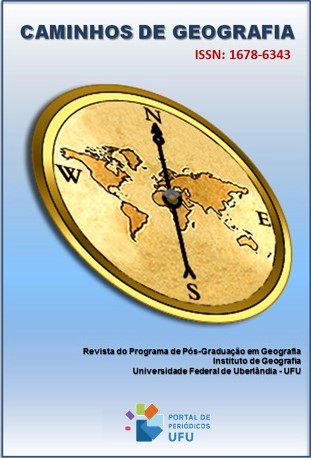EXPANSION OF AGRICULTURAL FRONTIER AND TRANSFORMATIONS IN LAND USE AND LAND COVER IN SURROUNDING AREAS TO INDIGENOUS LANDS IN SOUTHEASTERN MATO-GROSSENSE
DOI:
https://doi.org/10.14393/RCG249162476Keywords:
Indigenous peoples, Geotechnologies, Mapping, Cerrado BiomeAbstract
The occupation of the Southeast of Mato Grosso is marked by the arrival of the expansion front that advanced on indigenous territories around the 1930s, composed mainly of peasants and miners. In the following decades, the pioneering front arrived, building infrastructures and establishing properly capitalist relations of production, with the transformation of land into merchandise, production determined by the logic of the market, wage labor, the expropriation of peasants and the intensification of occupation. of the territory of indigenous peoples, who were in the process of “creating” indigenous lands (TIs), which made up a small part of their traditional territories. The objective of this research was to analyze, through a bibliographical review and the use of geotechnologies, how the historical process of occupation of traditional indigenous territories in the Southeast of Mato Grosso occurred and how these processes transformed the use and cover of the land in areas surrounding the indigenous lands between 1998 and 2018. The mapping of land use and land cover was done using images from the Landsat 8/OLI and Landsat 5/TM satellites. The analysis showed that these areas have little vegetation covers and great fragmentation of forest remnants, leaving indigenous lands isolated and surrounded by agricultural activity.
Downloads
Downloads
Published
How to Cite
Issue
Section
License
Copyright (c) 2023 Everaldo Rodrigues Mota Junior, Carline Biasoli Trentin, Edson Batista da Silva

This work is licensed under a Creative Commons Attribution-NonCommercial-NoDerivatives 4.0 International License.
Autores que publicam nesta revista concordam com os seguintes termos: a) Autores mantém os direitos autorais e concedem à revista o direito de primeira publicação, com o trabalho licenciado sob a Creative Commons Atribuição-NãoComercial-SemDerivações 4.0 Internacional. b) Autores têm permissão e são estimulados a publicar e distribuir seu trabalho online (ex.: em repositórios institucionais ou na sua página pessoal), já que isso pode gerar alterações produtivas, bem como aumentar o impacto e a citação do trabalho publicado. c) Em virtude de aparecerem nesta revista de acesso público, os artigos são de uso gratuito, com atribuições próprias, em aplicações educacionais e não-comerciais.











